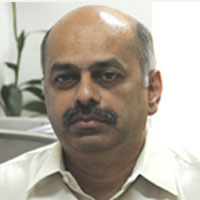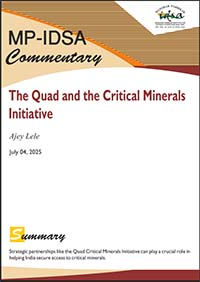The Quad and the Critical Minerals Initiative
- July 04, 2025 |
- IDSA Comments
At the Quad Foreign Ministers’ meeting on 1 July 2025 in Washington, D.C., discussions focused on the opportunities and challenges in the Indo-Pacific region. An important key outcome of this meeting was the launch of the Quad Critical Minerals Initiative. The grouping views this as an elaborate expansion of their partnership to strengthen economic security and collective resilience by collaborating to secure and diversify critical minerals supply chains.
Critical minerals are a division of minerals considered essential for the manufacturing and technological needs of industries, including the defence industry. The most important category of minerals known as rare earth elements (RREs) are vital for the electronic and green industry. They are also known to be essential towards production of electric vehicles, drones, battery storage and permanent magnets. RREs are also important to the business sectors which are involved in design and development of products involving new and advanced technologies. The Quad recognises that critical mineral availability hinges on several factors from the physical presence of deposits and whether countries are willing to mine them and have the technical capability to do so, to the economics involved in their mining and production and the complexities of global supply chains.
The 1 July 2025 Joint statement from the Quad foreign ministers clearly mentions that there are concerns about the abrupt constriction and future reliability of key supply chains, specifically for critical minerals. This includes the use of non-market policies and practices for critical minerals, certain derivative products and mineral processing technology. This joint statement underlines the importance of diversified and reliable global supply chains. The joint statement clearly emphasises that depending too heavily on any single country (read China) for processing and refining could leave industries vulnerable to economic coercion, price manipulation and disruptions. Obviously, all this would have a negative impact on Quad’s economic and national security structures. All this demands the need for diverse and dependable global supply chains.[i]
It is important to realise that in building partnerships to address the challenge of critical minerals, there are various bilateral and multilateral arrangements in vogue. In end April 2025, Ukraine and the US signed a deal to offer Washington access to valuable rare minerals. In June 2025 at the G7 Summit in Canada, the G7 leaders reiterated that they recognised that various critical minerals are the building blocks of future digital and energy-secure economies. Hence, they launched the G7 Critical Minerals Action Plan, building on the Five‑Point Plan initiated by Japan in 2023 and advanced by Italy in 2024. This was to ensure focus on expanding responsible production and supply, encouraging investment and value creation, and promoting innovation.[ii]
With the commencement of Trump 2.0, there has been renewed focus on strategic minerals. This shift is largely driven by the aggressive ‘tariff war’ started by Trump, particularly his efforts to economically pressure China. But China also fully understands its dominant position in the global minerals market and is leveraging this advantage to further its strategic and economic interests. All this is pushing the US and other industrialised countries to work towards reducing their dependence on China.
The Quad Critical Minerals Initiative should be viewed against this backdrop. For all these years, all four Quad members have been making investments in this sector to varying degrees. There is a realisation that the time has come for them to consolidate their strengths. There is a need for them to invest jointly and look for acquisition of mines in various parts of the world. Also, they need to invest in joint research and development and make coordinated efforts to identify alternative sources for critical minerals. In this context, it would be of interest to assess where India stands with respect to its critical minerals policy.
India and Critical Minerals
The Indian Bureau of Mines was set up on 1 March 1948. Subsequently, during 1957, the Mines and Minerals (Regulation and Development) Act was enacted so as to provide for the regulation of mines and development of minerals under the control of the Union. During the last six to seven decades, this Act has been amended some five/six times in keeping with changes in the policy on mineral development. The last amendment was carried out on 9 August 2023.[iii]
India’s demand for critical minerals has started growing, particularly with the rising emphasis on the electric vehicle (EV) sector. With the growing demand for critical minerals, it has become clear that the state needs to leapfrog in this domain. The need to establish a robust framework to achieve self-reliance in the critical minerals sector was strongly felt some years ago. In response, Finance Minister Nirmala Sitharaman announced the creation of a Critical Minerals Mission in the Union Budget for 2024–25 on 23 July 2024. Subsequently, in January 2025, the Union Cabinet approved the launch of the National Critical Minerals Mission (NCMM), with a planned expenditure of Rs 16,300 crore and an expected investment of Rs 18,000 crore by Public Sector Undertakings.
Consequently, the Ministry of Mines has auctioned 24 blocks of strategic minerals. Further, Geological Survey of India (GSI) has undertaken 368 exploration projects for critical minerals over the past three years. Moreover, Khanij Bidesh India Ltd. (KABIL), a joint venture of the Ministry of Mines, has acquired an area of about 15,703 Ha in the Catamarca province of Argentina, for exploration and mining of Lithium.[iv]
As per the list of critical minerals in July 2023, the Indian government has decided to focus on resources like rare earth elements (REE), lithium, molybdenum, potash, tungsten and graphite. India ended the year 2024 with a successful auction of 24 blocks out of 48. However, the high cost of investment in exploration appears to have deterred potential investors from joining in the bidding process. Also, there appears to be some lack of clarity on reserves.[v]
For India’s National Critical Minerals Mission to succeed, much more needs to be done. Reducing reliance on China and countering its dominance in the global minerals supply chain is essential. While the mission seeks to reduce the country’s dependence on imports and develop a robust domestic critical minerals industry, relying solely on domestic production will not be adequate to meet India’s growing needs. Hence, working in isolation is not advisable. Strategic partnerships like the Quad Critical Minerals Initiative, can play a crucial role in helping India secure access to critical minerals through joint investments, joint research and exploration, and shared technological expertise.
Views expressed are of the author and do not necessarily reflect the views of the Manohar Parrikar IDSA or of the Government of India.
[i] “Joint Statement from the Quad Foreign Ministers’ Meeting in Washington D.C. (July 01, 2025)”, Ministry of External Affairs, Government of India, 2 July 2025.
[ii] “G7 Critical Minerals Action Plan”, G7 Research Group, 17 June 2025.
[iii] “History”, Indian Bureau of Mines, Government of India; “The Mines and Minerals (Development and Regulation) Amendment Act, 2023”, The Gazette of India, 9 August 2023.
[iv] “Cabinet Approves ‘National Critical Mineral Mission’ to Build a Resilient Value Chain for Critical Mineral Resources Vital to Green Technologies, With an Outlay of Rs.34,300 crore Over Seven Years”, Press Information Bureau, Ministry of Mines, Government of India, 29 January 2025; “Auction for Critical Mineral Blocks”, Ministry of Mines, Government of India, 31 July 2024.
[v] “Critical Mineral Push: Exploration Up 53%, But Auction Hurdles Persist”, Business Standard, 2 January 2025.






